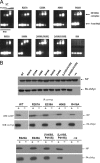Functional analysis of the influenza virus H5N1 nucleoprotein tail loop reveals amino acids that are crucial for oligomerization and ribonucleoprotein activities
- PMID: 20463064
- PMCID: PMC2898228
- DOI: 10.1128/JVI.02474-09
Functional analysis of the influenza virus H5N1 nucleoprotein tail loop reveals amino acids that are crucial for oligomerization and ribonucleoprotein activities
Abstract
Homo-oligomerization of the nucleoprotein (NP) of influenza A virus is crucial for providing a major structural framework for the assembly of viral ribonucleoprotein (RNP) particles. The nucleoprotein is also essential for transcription and replication during the virus life cycle. In the H5N1 NP structure, the tail loop region is important for NP to form oligomers. Here, by an RNP reconstitution assay, we identified eight NP mutants that had different degrees of defects in forming functional RNPs, with the RNP activities of four mutants being totally abolished (E339A, V408S P410S, R416A, and L418S P419S mutants) and the RNP activities of the other four mutants being more than 50% decreased (R267A, I406S, R422A, and E449A mutants). Further characterization by static light scattering showed that the totally defective protein variants existed as monomers in vitro, deviating from the trimeric/oligomeric form of wild-type NP. The I406S, R422A, and E449A variants existed as a mixture of unstable oligomers, thus resulting in a reduction of RNP activity. Although the R267A variant existed as a monomer in vitro, it resumed an oligomeric form upon the addition of RNA and retained a certain degree of RNP activity. Our data suggest that there are three factors that govern the NP oligomerization event: (i) interaction between the tail loop and the insertion groove, (ii) maintenance of the tail loop conformation, and (iii) stabilization of the NP homo-oligomer. The work presented here provides information for the design of NP inhibitors for combating influenza virus infection.
Figures





Similar articles
-
Structure and sequence analysis of influenza A virus nucleoprotein.Sci China C Life Sci. 2009 May;52(5):439-49. doi: 10.1007/s11427-009-0064-x. Epub 2009 May 27. Sci China C Life Sci. 2009. PMID: 19471866 Review.
-
Mutational analysis of conserved amino acids in the influenza A virus nucleoprotein.J Virol. 2009 May;83(9):4153-62. doi: 10.1128/JVI.02642-08. Epub 2009 Feb 18. J Virol. 2009. PMID: 19225007 Free PMC article.
-
Amino acid substitutions affecting aspartic acid 605 and valine 606 decrease the interaction strength between the influenza virus RNA polymerase PB2 '627' domain and the viral nucleoprotein.PLoS One. 2018 Jan 16;13(1):e0191226. doi: 10.1371/journal.pone.0191226. eCollection 2018. PLoS One. 2018. PMID: 29338047 Free PMC article.
-
Molecular dynamics studies of the nucleoprotein of influenza A virus: role of the protein flexibility in RNA binding.PLoS One. 2012;7(1):e30038. doi: 10.1371/journal.pone.0030038. Epub 2012 Jan 17. PLoS One. 2012. PMID: 22272272 Free PMC article.
-
Identification and characterization of three novel nuclear export signals in the influenza A virus nucleoprotein.J Virol. 2012 May;86(9):4970-80. doi: 10.1128/JVI.06159-11. Epub 2012 Feb 15. J Virol. 2012. PMID: 22345439 Free PMC article.
Cited by
-
E339...R416 salt bridge of nucleoprotein as a feasible target for influenza virus inhibitors.Proc Natl Acad Sci U S A. 2011 Oct 4;108(40):16515-20. doi: 10.1073/pnas.1113107108. Epub 2011 Sep 19. Proc Natl Acad Sci U S A. 2011. PMID: 21930946 Free PMC article.
-
Pre-mRNA Processing Factor Prp18 Is a Stimulatory Factor of Influenza Virus RNA Synthesis and Possesses Nucleoprotein Chaperone Activity.J Virol. 2017 Jan 18;91(3):e01398-16. doi: 10.1128/JVI.01398-16. Print 2017 Feb 1. J Virol. 2017. PMID: 27852861 Free PMC article.
-
Identification of small molecule inhibitors for influenza a virus using in silico and in vitro approaches.PLoS One. 2017 Mar 8;12(3):e0173582. doi: 10.1371/journal.pone.0173582. eCollection 2017. PLoS One. 2017. PMID: 28273150 Free PMC article.
-
Phosphorylation at the homotypic interface regulates nucleoprotein oligomerization and assembly of the influenza virus replication machinery.PLoS Pathog. 2015 Apr 13;11(4):e1004826. doi: 10.1371/journal.ppat.1004826. eCollection 2015 Apr. PLoS Pathog. 2015. PMID: 25867750 Free PMC article.
-
Sequence in the influenza A virus nucleoprotein required for viral polymerase binding and RNA synthesis.J Virol. 2012 Jul;86(13):7292-7. doi: 10.1128/JVI.00014-12. Epub 2012 Apr 24. J Virol. 2012. PMID: 22532672 Free PMC article.
References
-
- Albertini, A. A., A. K. Wernimont, T. Muziol, R. B. Ravelli, C. R. Clapier, G. Schoehn, W. Weissenhorn, and R. W. Ruigrok. 2006. Crystal structure of the rabies virus nucleoprotein-RNA complex. Science 313:360-363. - PubMed
Publication types
MeSH terms
Substances
Grants and funding
LinkOut - more resources
Full Text Sources
Medical
Miscellaneous

